Grand Est
Grand Est[2] ("Great East"; French pronunciation: [ɡʁɑ̃t‿ɛst] (![]()
Grand Est | |
|---|---|
 | |
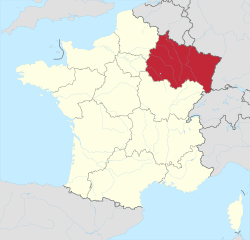 | |
| Country | |
| Prefecture | Strasbourg |
| Departments | |
| Government | |
| • Body | Regional council of Grand Est |
| • President of the Regional Council | Jean Rottner (The Republicans) |
| Area | |
| • Total | 57,433 km2 (22,175 sq mi) |
| Area rank | 5th |
| Population (2017)[1] | |
| • Total | 5,549,586 |
| • Density | 97/km2 (250/sq mi) |
| Time zone | UTC+01:00 (CET) |
| • Summer (DST) | UTC+02:00 (CEST) |
| ISO 3166 code | FR-GES |
| GDP (2013) | Ranked |
| Total | €150.3 billion (US$207.0 bn) |
| Per capita | €27,085 (US$37,312) |
| NUTS Region | FRF |
| Website | http://www.grandest.fr |
The region sits astride three water basins (Seine, Meuse and Rhine), spanning an area of 57,433 km2 (22,175 sq mi), the 5th largest in France, and includes two mountain ranges (Vosges and Ardennes). It shares borders with Belgium, Luxembourg, Germany, and Switzerland, and stands partly within the European Megalopolis. As of 2017, it had a population of 5,549,586 inhabitants. The administrative capital and largest city, by far, is Strasbourg.
The East of France has a rich and diverse culture, being situated at a crossroads between the Latin and Germanic worlds which is reflected in the variety of languages spoken there (Alsatian, Champenois, Lorraine Franconian etc.). Most of today's Grand Est region was considered "Eastern" as early as the 8th century, when it constituted the southern part of the Francian territory of Austrasia. The city of Reims (in Champagne), where Frankish king Clovis I had been baptized in 496 AD, would later play a prominent ceremonial role in French monarchical history as the traditional site of the coronation of the kings of France. The Champagne fairs played a significant role in the economy of medieval Europe as well. Alsace and Lorraine thrived in the sphere of influence of the Holy Roman Empire for most of the Middle Ages and Renaissance. The region is home to distinctive traditions (the celebration of Saint Nicholas Day, Christmas markets, or traditions involving the Easter hare in Alsace and Lorraine). Alsace-Moselle are furthermore subject to local law for historical reasons. With a long industrial history as well and its agriculture and tourism (arts, gastronomy, sightseeing etc.), the East of France is one of the top economic producing regions in the country.
Toponymy
Provisional name
The provisional name of the region was Alsace-Champagne-Ardenne-Lorraine, formed by combining the names of the three present regions—Alsace, Champagne-Ardenne, and Lorraine—in alphabetical order with hyphens. The formula for the provisional name of the region was established by the territorial reform law and applied to all but one of the provisional names for new regions.[5] The ACAL regional council, which was elected in December 2015, was given the task of choosing a name for the region and submitting it to the Conseil d'État—France's highest authority for administrative law—by 1 July 2016 for approval.[5][7] The provisional name of the region was retired on 30 September 2016, when the new name of the region, Grand Est, took effect.[6]
In Alsace and in Lorraine, the new region has frequently been called ALCA, for Alsace-Lorraine-Champagne-Ardennes, on the internet.[8]
Like the name Région Hauts-de-France (and, until 2015, the name Région Centre), the name Région Grand Est contains no reference whatsoever to the area's history or identity, but merely describes its geographical location within metropolitan France.
Permanent name
In a poll conducted in November 2014 by France 3 in Champagne-Ardenne, Grand Est (29.16%) and Austrasie (22.65%) were the top two names among 25 candidates and 4,701 votes.[9] Grand Est also topped a poll the following month conducted by L'Est Républicain, receiving 42% of 3,324 votes.[10]
The names which received a moderate amount of discussion were:
- Grand Est français, a term used to refer to the northeast quarter of Metropolitan France, although this term refers to a geographic region larger than just ACAL. The term has been commonly used and topped the polls mentioned above.
- Grand Est Europe (Great East Europe), a variant of Grand Est that alludes to the region being a gateway to Europe both through trade and since Strasbourg is home to several European institutions (which makes it one of the three unofficial capitals of the European Union).[11] However, the name was mocked for how it could suggest that the region is in Eastern Europe.[12]
- Austrasie (Austrasia), which refers to an historical region spanning parts of present-day northeast France, the Benelux, and northwest Germany.[9][10]
- Quatre frontières (Four Frontiers), which refers to the region's border with four countries.[9]
Geography
Grand Est covers 57,433 square kilometres (22,175 sq mi) of land and is the sixth-largest of the regions of France. Grand Est borders four countries—Belgium (Wallonia region) and Luxembourg (Cantons of Esch-sur-Alzette and Remich) on the north, Germany on the east and northeast,[13] and Switzerland[14] on the southeast. It is the only French region to border more than two countries, or more countries than French regions. Its neighbors within France are Bourgogne-Franche-Comté on the south, Île-de-France on the west, and Hauts-de-France on the northwest.
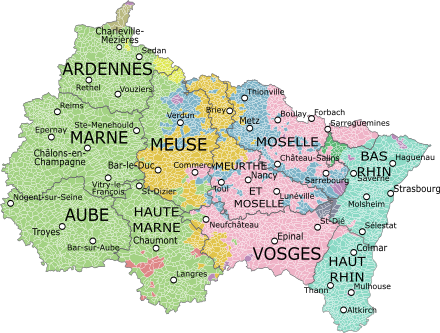
Departments
Grand Est contains ten departments: Ardennes, Aube, Bas-Rhin, Marne, Haute-Marne, Haut-Rhin, Meurthe-et-Moselle, Meuse, Moselle, Vosges.
Topography
The main ranges in the region include the Vosges to the east and the Ardennes to the north.
Hydrology
The region is bordered on the east by the Rhine, which forms about half of the border with Germany. Other major rivers which flow through the region include the Meuse, Moselle, Marne, and Saône.
Lakes in the region include lac de Gérardmer, lac de Longemer, lac de Retournemer, lac des Corbeaux, Lac de Bouzey, lac de Madine, étang du Stock and lac de Pierre-Percée.
Climate
Grand Est climate depends of the proximity of the sea. In Champagne and Western Lorraine, the climate is oceanic (Köppen : Cfb), with cool to mild winters and warm summers. But Ardennes, Moselle and Alsace climates are borderline humid continental (Köppen : Dfb) - oceanic (Köppen : Cfb), characterized by cold winters with frequent days below the freezing point, and hot summers, with many days with temperatures up to 32 °C.
History
Formation
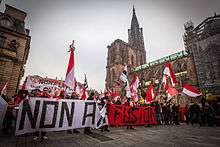
Grand Est is the result of territorial reform legislation passed in 2014 by the French Parliament to reduce the number of regions in Metropolitan France—the part of France in continental Europe—from 22 to 13.[15] Grand Est is the merger of three regions: Alsace, Champagne-Ardenne, and Lorraine.
Opposition
The merger has been, and still is, strongly opposed by some groups in Alsace, and a large majority of Alsatians.[16][17] The territorial reform law allows new regions to choose the seat of the regional councils, but specifically made Strasbourg the seat of the Grand Est regional council—a move to appease the region's politicians.[18]
The creation of the new region was unpopular among Alsatians. In response, the Government created the European Collectivity of Alsace merging the departments of Bas Rhin and Haut Rhin, to take effect in 2021.
Demographics
The region has an official population of 5,549,586 (municipal population on 1 January 2017).[1]
| Cities with over 20,000 inhabitants | Former region | 2017 |
|---|---|---|
| Strasbourg | Alsace | 280,966 |
| Reims | Champagne-Ardenne | 182,460 |
| Metz | Lorraine | 116,429 |
| Mulhouse | Alsace | 109,443 |
| Nancy | Lorraine | 104,286 |
| Colmar | Alsace | 69,105 |
| Troyes | Champagne-Ardenne | 61,652 |
| Charleville-Mézières | Champagne-Ardenne | 46,428 |
| Châlons-en-Champagne | Champagne-Ardenne | 44,753 |
| Thionville | Lorraine | 40,701 |
| Haguenau | Alsace | 34,504 |
| Schiltigheim | Alsace | 31,894 |
| Épinal | Lorraine | 31,740 |
| Vandœuvre-lès-Nancy | Lorraine | 30,02 |
| Illkirch-Graffenstaden | Alsace | 26,780 |
| Saint-Dizier | Champagne-Ardenne | 24,012 |
| Épernay | Champagne-Ardenne | 22,671 |
| Chaumont | Champagne-Ardenne | 21,945 |
| Montigny-lès-Metz | Lorraine | 21,813 |
| Forbach | Lorraine | 21,552 |
| Saint-Louis | Alsace | 21,177 |
| Sarreguemines | Lorraine | 20,783 |
| 2017 Rank | Department | Legal Population in 2017 | Area (km²) | Aroen (Pop./km²) | INSEE Dept. No. |
|---|---|---|---|---|---|
| 1 | Bas-Rhin | 1,125,559 | 4,755 | 237 | 67 |
| 2 | Moselle | 1,043,552 | 6,216 | 168 | 57 |
| 3 | Haut-Rhin | 764,030 | 3,525 | 217 | 68 |
| 4 | Meurthe-et-Moselle | 733,481 | 5,246 | 140 | 54 |
| 5 | Marne | 568,895 | 8,162 | 70 | 51 |
| 6 | Vosges | 367,673 | 5,874 | 62.5 | 88 |
| 7 | Aube | 310,020 | 6,004 | 51.5 | 10 |
| 8 | Ardennes | 273,579 | 5,229 | 52 | 08 |
| 9 | Meuse | 187,187 | 6,211 | 30 | 55 |
| 10 | Haute-Marne | 175,640 | 6,211 | 28 | 52 |
Government
Regional council
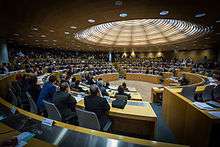

The regional council has limited administrative authority, mostly concerning the promotion of the region's economy and financing educational and cultural activities. The regional council has no legislative authority. The seat of the regional council will be Strasbourg. The regional council, elected in December 2015, is controlled by The Republicans.[19] The elected inaugural president of the Grand Est Regional Council is Philippe Richert, who was previously the President of the Alsace Regional Council.[19] The current president is Jean Rottner.
Economy
The gross domestic product (GDP) of the region was 159.9 billion euros in 2018, accounting for 6.7% of French economic output. GDP per capita adjusted for purchasing power was 25,400 euros or 84% of the EU27 average in the same year. The GDP per employee was 101% of the EU average.[20]
Transport and infrastructure
Rail transport
The region has five tram networks:
Airports
The region has four airports:
Motorways
The region has eighteen motorways:
- A4 Paris to Strasbourg
- A5 Paris to Langres
- A26 Calais to Troyes
- A30 Uckange to Longwy in N52
- A31 Beaune to Luxembourg in A3 motorway (Luxembourg)
- A33 Nancy to Phalsbourg in N4
- A34 Reims to Sedan
- A35 Strasbourg to Basel
- A36 Beaune to Mulhouse
- A304 project in city of Charleville-Mézières
- A313 in city of Pont-à-Mousson
- A314 and A315 in city of Metz
- A320 in city of Forbach
- A330 in city of Nancy
- A340 Brumath to Haguenau in D1340
- A344 in city of Reims
- A351 in city of Strasbourg
- A352 Molsheim to Schirmeck in D1420
The region has twelve cities that have ring roads:
- Strasbourg
- Reims
- Metz
- Nancy
- Mulhouse
- Troyes
- Châlons-en-Champagne
- Épinal
- Colmar
- Thionville
- Longwy
Heritage

Grand Est is rich with architectural monuments from the Roman Empire to the early 21st century.
Gothic architecture is particularly conspicuous, with many famous cathedrals, basilicas and churches, such as Reims Cathedral, Strasbourg Cathedral, Metz Cathedral, Troyes Cathedral, Châlons Cathedral, Toul Cathedral, the Basilica of L'Épine, the Basilica of Saint-Nicolas-de-Port, the Basillica of Avioth, the Basilica of St. Urbain in Troyes, Thann Church, Niederhaslach Church, Notre-Dame-en-Vaux, St. George's Church, Sélestat and St. Peter and St. Paul's Church, Wissembourg.
See also
Notes
- The name Alsace-Champagne-Ardenne-Lorraine was created by hyphenating the merged regions' names in alphabetical order; the regional council had to approve a new name for the region by 1 July 2016.[5] France's Conseil d'État approved Grand Est as the new name of the region on 28 September 2016, effective 30 September 2016.[6]
References
- "Populations légales 2017". insee.fr. Retrieved 2 January 2020.
- ""Grand Est": les élus valident le nom de région". Le Figaro (in French). Retrieved 29 April 2016.
- Dupuis-Remond, Dupuis-Remond (18 December 2014). "Débat d'orientation budgétaire : la Grande Région ALCA dans tous les esprits – France 3 Lorraine". France 3 (in French). Retrieved 13 January 2015.
- "La carte à 13 régions définitivement adoptée". Le Monde (in French). Agence France-Presse. 17 December 2014. Retrieved 13 January 2015.
- Loi n° 2015–29 du 16 janvier 2015 relative à la délimitation des régions, aux élections régionales et départementales et modifiant le calendrier électoral, article 2(I) (in French)
- Décret n° 2016-1262 du 28 septembre 2016 portant fixation du nom de la région Grand Est (in French)
- Quel nom pour la nouvelle région ? Vous avez choisi..., Sud-Ouest, 4 December 2014. Retrieved 2 January 2015
- "Cette région que l'Alsace ne veut pas baptiser". Dernières Nouvelles d'Alsace (in French). 7 December 2014. Retrieved 25 August 2015.
- "Votez pour le nom de la future grande région Champagne-Ardenne – Lorraine – Alsace". France 3 Champagne-Ardenne (in French). France Télévisions. 24 November 2014. Retrieved 25 August 2015.
- "Choisissez un nom pour la Grande Région". L'Est Républicain (in French). 2 December 2014. Retrieved 25 August 2015.
- Bach, Christian (21 June 2015). "Région Alsace-Lorraine-Champagne-Ardenne : le nom de la chose..." Derniers nouvelles d'Alsace (in French). Retrieved 25 August 2015.
- Baldit, Etienne (21 July 2015). "Philippot refuse le nom 'Grand Est Europe' pour sa région : "Et pourquoi pas 'Roumanie' ?"". Europe 1 (in French). Retrieved 25 August 2015.
- Baden-Württemberg, Rhineland-Palatinate and Saarland
- Cantons of Basel-Landschaft, Basel-Stadt, Jura and Solothurn
- "La carte à 13 régions définitivement adoptée". Le Monde (in French). 17 December 2014. Retrieved 27 October 2015.
- "Le malaise Alsacien ne décroit pas". L'Alsace (in French). 21 February 2018. Retrieved 21 February 2018.
- "Grand Est: Philippe Richert, le "fossoyeur" de l'Alsace, démissionne". L'Express (in French). 30 September 2017. Retrieved 27 November 2017.
- "Strasbourg sera la capitale de la future région Alsace-Champagne-Ardenne-Lorraine". Le Monde (in French). 20 November 2014. Retrieved 25 August 2015.
[Members of the National Assembly] decided Thursday, 20 November to designate in advance Strasbourg as the capital of the future region Alsace-Champagne-Ardenne-Lorraine in a gesture to appease the Alsatian politicians. (From French: Les députés ont décidé jeudi 20 novembre de désigner par avance Strasbourg comme capitale de la future grande région Alsace-Champagne-Ardenne-Lorraine dans un geste d'apaisement vis-à-vis des élus alsaciens.)
- "Alsace – Champagne-Ardenne – Lorraine: Nouveau Conseil Régional". Elections régionales et des assemblées de Corse, Guyane et Martinique 2015. Ministre de l’Intérieur. Retrieved 14 December 2015.
- "Regional GDP per capita ranged from 30% to 263% of the EU average in 2018". Eurostat.
External links
| Wikivoyage has a travel guide for Grand-Est. |
- Official Website (in French)
- Merger of the regions – France 3
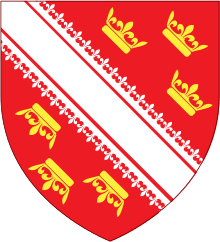
.svg.png)
